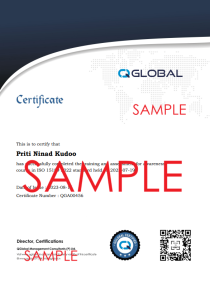Evaluation of Measurement Uncertainty
- Description
- Curriculum

Measurement uncertainty is an essential feature of all tests and calibrations. It can be used to estimate a range for values that could reasonably, with some defined probability, be attributed to a measured quantity. It is vitally crucial to account for measurement uncertainty whenever a conformity decision statement (e.g. pass/fail) is made. This course is designed to provide delegates with detailed view of uncertainty, traceability, uncertainty budgets, their components and pass/fail criteria (decision rules) relating to ISO/IEC 17025 compliance.
Who Should Attend?
- Laboratory directors, quality managers and technical managers
- Laboratory personnel responsible for the calculation & review of uncertainties
- Those auditing laboratory management system
- Organizations seeking or maintaining accreditation to ISO/IEC 17025
- Consultants and trainers
Key Benefits
- Design the framework for analysis of measurement uncertainty
- Understand the important terms related to uncertainty estimation such as mean, standard deviation, accuracy, precision, expanded uncertainty, error, Type A and Type B uncertainties, standard uncertainty etc
- Identify the sources of measurement uncertainty
- Learn to pick the right probability distribution for each uncertainty component
- Learn how to use the GUM method for estimating measurement uncertainty
- Learn to convert uncertainty components to a standard uncertainty
- Learn to combine uncertainty components using the GUM method
- Understand how to pick the right expansion factor (k-factor)
- Learn to calculate expanded uncertainty
- Understand how to report measurement uncertainty in laboratory reports
- Estimation of measurement uncertainty of components having same units
- Estimation of measurement uncertainty of components having different units
- Learn to apply the effect of measurement uncertainty while providing statement of conformity in test reports and calibration certificates
Learning & Evaluation Method
This is a self learning course. Study materials will be available in your account once you purchase the course. If you need a live and interactive course, you can opt for ‘ BUY FOR A GROUP ‘ option. Live course will have role plays, online workshops, practice questions and group discussions during the course so that each participant will gain in depth knowledge in the subject. Group purchase can be made for a single participant or for a group of participants. On receiving your order, our team will contact you to schedule a live training session as per your convenience.
Certification
There are increasing numbers of organizations, who prefer candidates those who have completed management system trainings from a recognized institution. Certification demonstrates your commitment to superior professionalism, upholding industry standards, and continued learning. These merits can help boost your professional credibility and prestige within your own network, in your organisation, with your current clients, and when pursuing new business opportunities. After the successful completion of the course and final exam, you will be awarded with a certificate of completion issued by QGlobal. Your credentials will be made available in the global online directory and can be verified by anyone searching with the certificate number. Without doubt we can say that our training courses are well recognized and sought after by organizations across various geographies.
Buy for group Are you planning to buy this course for a group? We have the best prices for you! Select ‘Buy for Group’ option and add to the cart. You will get a discount of 60 – 75% for a group of up to 10 participants. To make a group purchase, create your group name and add individual emails of up to 10 participants. Each participant will get the access to the course materials, exam and the certificate. We will arrange one live-online session for the entire group.
Total: 205 Courses View all
Total: 205 Courses View all
-
1MU01 Terms and definitions
-
2MU02 Introduction to uncertainty in measurement
- What is not a measurement uncertainty?
-
3MU03 Estimation of uncertainty using GUM approach
-
4MU04 Sources of measurement uncertainty
-
5MU05 Evaluation of standard uncertainty
- Modeling the Measurement
- Type A evaluation of standard uncertainty
- Type B evaluation of standard uncertainty
- Examples of Type B estimation of standard uncertainty
- Examples of Type B evaluation of standard uncertainty:
-
6MU06 Evaluation of combined standard uncertainty
- Uncorrelated input quantities
-
7MU07 Expanded uncertainty in measurement
- Expanded uncertainty
- Choosing a coverage factor
- Apportionment of standard uncertainty
- Schematic view of an Uncertainty Budget
-
8MU08 Procedure for estimating the uncertainty in measurement
- Step 1
- Examples
- Step 2
- Step 3
- Step 4
- Step 5
- Step 6
- Step 7
- Step 8
- Step 9
-
9MU09 Probability distribution
- A1 Normal distribution
- When to use normal distribution
- Table A.1: Confidence Level and the corresponding Coverage factor (k)
- A.2 Rectangular distribution
- When to use rectangular distribution
- A.3 Symmetrical Trapezoidal Distribution
- Triangular Distribution
- A.4 U-Shaped Distribution
-
10MU10 Coverage factor
- Type A Evaluation
- Type B Evaluation
- Interpretation on effective degrees of freedom
-
11MU11 Expressing measurement uncertainty
-
12MU12 Uncertainty estimation using methods other than GUM approach
- Use of repeatability, reproducibility and trueness estimates in measurement uncertainty estimation
- Procedure for evaluating Measurement Uncertainty using ISO 21748:2010.
- Continued verification of performance
- Uncertainty estimation
- Use of control charts for estimation of measurement uncertainty
- Test for which measurement uncertainty estimation does not apply



























































